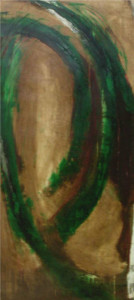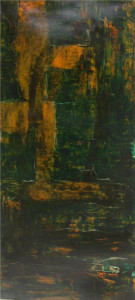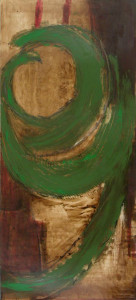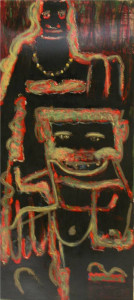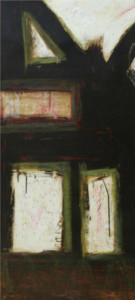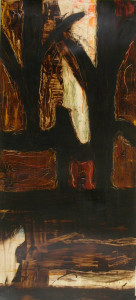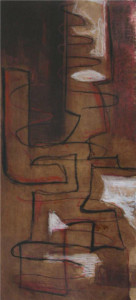A Signature Year: The Goddess Mother Earth in Green and Brown
In this series (A Panel with 7 paintings displayed) Salazar combines primitivism with abstract expressionism. This series of images appears to be a meditation or dream. If regarded as one vision, or revelation perhaps, the viewer may note the predominance of green and energy in the three paintings to the left. “Mother Earth” is freer, evolving, productive. She bursts through the tawny earth.
In the third image – just as her green energy reaches its most dynamic potential – two curiously linear strokes of red appear at the top of the paper. Why? Are they intended to hold down her potential? Are they thrown off from her surging energy like sparks from a roiling fire? Green and red? Chlorophyl and blood, perhaps?
In the fourth and central image – the most troubling one – two dark female figures emerge. Is it “Mother Earth” in two guises? If it is, why is the one in the background saddened? Beautiful, flowing hair cascades down one side of her face. On the other side the hair seems lifeless by comparison. It drops without a wave or curl from the top of her head to two enigmatic forms. Are they phalluses? In the red background behind her head are phallic forms. Are those elongated forms in the lower left of the image also phalluses?
Ironically, the phallic-like images do not evoke eroticism. Nor does this image suggest fertility. The potential fecundity of the first three images is absent. Sensuality seems in retreat. Only the flow of hair to one side of the upper figure’s head reminds of human sexuality. Is humanity’s relationship to the fecundity of the earth – to the very animal nature of being alive – somehow broken?
The answer to this and the earlier questions is likely important, but it is a matter of speculation and interpretation. What is clear is that the lower figure is more sinister and hungry. In contrast to the upper figure, this lower one is full-breasted though it has an aggressive masculine aspect. The upper figure wears a graceful necklace. She appears to be partially clothed. She is cultured, yet her breasts are covered. Could it be that human culture is estranged from Nature? Have humans become the greedy, hungry beast that devours its mother?
And what is the spear-like (scepter?) form next to the sinister figure? Is it rooted in the ground? What remains of the color green in this image is more sublimated, mixed with hints of yellow. The sharpest green appears in the upper background, mere fragments of the greens in the earlier three images.
The last three images to the viewer’s right have less organic appeal. The are just as strong, however. The lines of two of them are dark and bold, more forcefully constructed. Darker tones dominate these two. The only green is less intense. The muted green outlines white spaces, sometimes dripping into the fields of white with hints of red. A rectangle of red appears at the center of one of them. The red (heart?) appears to cast a beam of light up through two dark tree-like forms. The white tones in these two paintings give relief to the dark constructions.
Dark colors hardly disturb the harmony of the last image to the far right of the viewer. Most the surface here is a pleasantly warm brown with darkness intruding only from the upper right of the paper. The flow of black lines with red tracings and a field of red blended into the brown background add to the mystery of this last painting, as do the blotches of white. The black lines are exquisite, sometimes curving but mostly straight or angular.
Again, Salazar has worked chapapote into the Stonehenge Paper in varied ways. It imparts an earthiness to his images. Each of these fine paintings can stand on its own artistic merits. Taken as a series, however, the viewer is invited to join the artist on a journey into the subconscious world where his/her relationship to “Mother Earth” returns to mythic proportions.
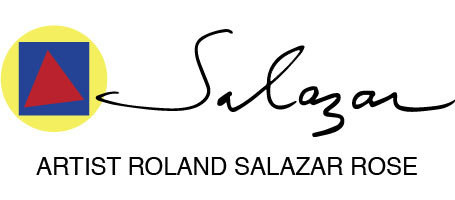 Salazar
Salazar